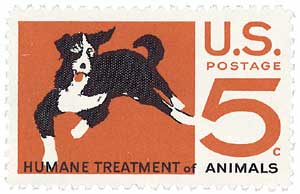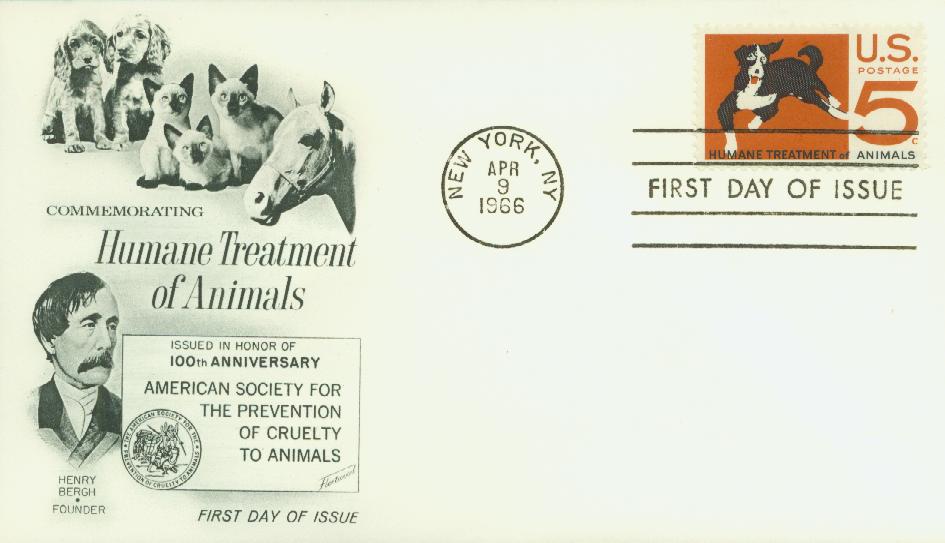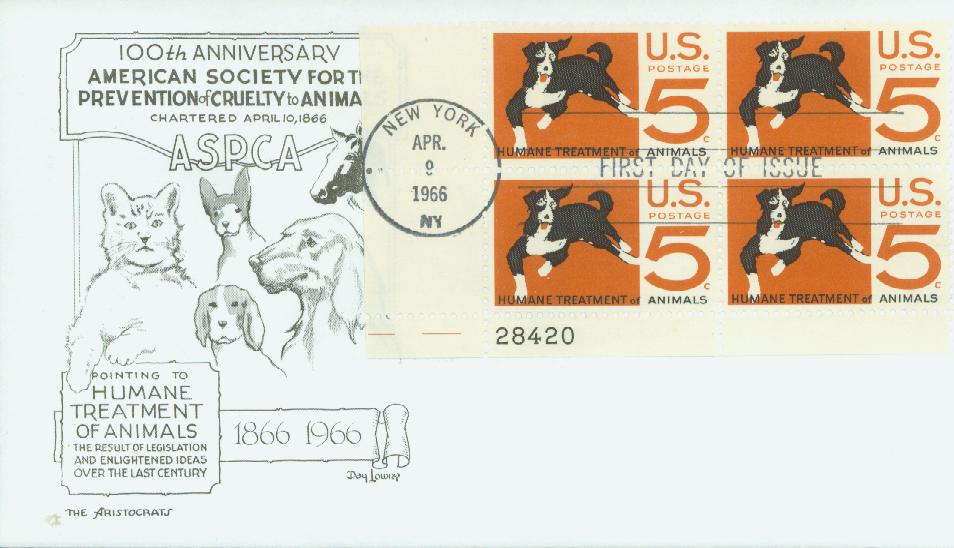
# 1307 - 1966 5c Humane Treatment of Animals
5¢ ASPCA
City: New York, NY
Quantity: 117,470,000
Printed By: Bureau of Engraving and Printing
Printing Method: Lithographed, engraved
Perforations: 11
Color: Orange brown and black
ASPCA

On April 10, 1866, Henry Bergh founded the American Society for the Prevention of Cruelty to Animals (ASPCA).
Animals were regarded as property throughout history, and most laws served to protect people from them rather than prevent animal cruelty. While in Europe on a diplomatic mission, Bergh was distressed by the cruel treatment against animals that he witnessed.

On his return trip, Bergh passed through England where he met Lord Harrowby, the president of the Royal Society for the Prevention of Cruelty to Animals. Harrowby had a significant impact on Bergh and inspired him to dedicate his life to putting an end to animal cruelty. He resolved that he would not only create an organization to protect animals, but also that they would have the power to arrest and prosecute those that violated the law.

After returning to America, Bergh was especially disturbed to witness the cruelty inflicted on New York City’s working horses. He was determined to change common perceptions of acceptable behavior toward animals. In one public address he spoke eloquently saying, “This is a matter purely of conscience; it has no perplexing side issues. It is a moral question in all its aspects.” At the heart of Bergh’s philosophy was that protecting animals was everyone’s responsibility. His words moved his audience and encouraged several dignitaries to sign his “Declaration of the Rights of Animals.”

Armed with the support of prominent dignitaries, Bergh lobbied the New York State Legislature to pass a law protecting animals. The charter given to incorporate the American Society for the Prevention of Cruelty to Animals was passed on April 10, 1866. Nine days later, New York State passed an anti-cruelty law and granted the ASPCA the authority to enforce it.

Bergh was very involved in the ASPCA’s work. He was often found in the streets and courtrooms fighting for animal welfare. He inspected slaughterhouses, helped the police close down dog and rat fighting pits, and spoke at schools and organization meetings. The society operated the first equestrian ambulance, developed a sling to rescue horses, and supplied fresh drinking water for Manhattan’s horses.
By the time of Bergh’s death in 1888, 37 of 38 states in the Union had enacted anti-cruelty laws. In the early 1900s, the ASPCAs focus shifted more to small domestic animals such as dogs and cats. Today, the ASPCA focuses on sheltering abandoned animals, adoption programs, and spaying and neutering advocacy.
Click here for more animal stamps.
Click here for more from the ASPCA website.
5¢ ASPCA
City: New York, NY
Quantity: 117,470,000
Printed By: Bureau of Engraving and Printing
Printing Method: Lithographed, engraved
Perforations: 11
Color: Orange brown and black
ASPCA

On April 10, 1866, Henry Bergh founded the American Society for the Prevention of Cruelty to Animals (ASPCA).
Animals were regarded as property throughout history, and most laws served to protect people from them rather than prevent animal cruelty. While in Europe on a diplomatic mission, Bergh was distressed by the cruel treatment against animals that he witnessed.

On his return trip, Bergh passed through England where he met Lord Harrowby, the president of the Royal Society for the Prevention of Cruelty to Animals. Harrowby had a significant impact on Bergh and inspired him to dedicate his life to putting an end to animal cruelty. He resolved that he would not only create an organization to protect animals, but also that they would have the power to arrest and prosecute those that violated the law.

After returning to America, Bergh was especially disturbed to witness the cruelty inflicted on New York City’s working horses. He was determined to change common perceptions of acceptable behavior toward animals. In one public address he spoke eloquently saying, “This is a matter purely of conscience; it has no perplexing side issues. It is a moral question in all its aspects.” At the heart of Bergh’s philosophy was that protecting animals was everyone’s responsibility. His words moved his audience and encouraged several dignitaries to sign his “Declaration of the Rights of Animals.”

Armed with the support of prominent dignitaries, Bergh lobbied the New York State Legislature to pass a law protecting animals. The charter given to incorporate the American Society for the Prevention of Cruelty to Animals was passed on April 10, 1866. Nine days later, New York State passed an anti-cruelty law and granted the ASPCA the authority to enforce it.

Bergh was very involved in the ASPCA’s work. He was often found in the streets and courtrooms fighting for animal welfare. He inspected slaughterhouses, helped the police close down dog and rat fighting pits, and spoke at schools and organization meetings. The society operated the first equestrian ambulance, developed a sling to rescue horses, and supplied fresh drinking water for Manhattan’s horses.
By the time of Bergh’s death in 1888, 37 of 38 states in the Union had enacted anti-cruelty laws. In the early 1900s, the ASPCAs focus shifted more to small domestic animals such as dogs and cats. Today, the ASPCA focuses on sheltering abandoned animals, adoption programs, and spaying and neutering advocacy.
Click here for more animal stamps.
Click here for more from the ASPCA website.










